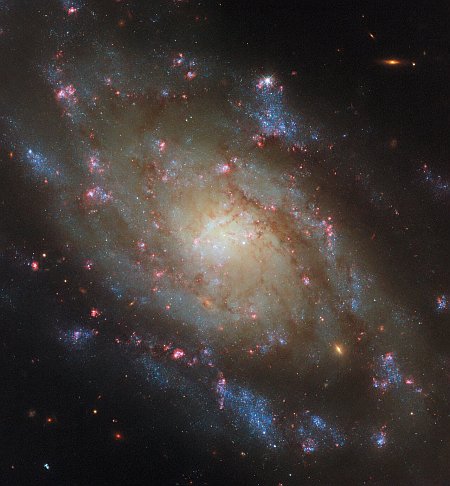A galaxy surrounded by clusters of hot massive stars
Cool image time! The picture to the right, reduced and sharpened to post here, was taken by the Hubble Space Telescope of the galaxy NGC 5042, located about 48 million light years away. The picture combines data from all of Hubble’s available wavelengths from the ultraviolet to the infrared. From the caption:
Perhaps NGC 5042’s most striking feature is its collection of brilliant pink gas clouds that are studded throughout its spiral arms. These flashy clouds are called H II (pronounced “H-two”) regions, and they get their distinctive colour from hydrogen atoms that have been ionised by ultraviolet light. If you look closely at this image, you’ll see that many of these reddish clouds are associated with clumps of blue stars, often appearing to form a shell around the stars.
H II regions arise in expansive clouds of hydrogen gas, and only hot and massive stars [indicated by blue] produce enough high-energy light to create an H II region. Because the stars capable of creating H II regions only live for a few million years — just a blink of an eye in galactic terms — this image represents a fleeting snapshot of life in this galaxy.
The image also includes one star (distinguished by its four diffraction spikes) and a few background galaxies in yellow, the most obvious found in the upper and lower right.
On Christmas Eve 1968 three Americans became the first humans to visit another world. What they did to celebrate was unexpected and profound, and will be remembered throughout all human history. Genesis: the Story of Apollo 8, Robert Zimmerman's classic history of humanity's first journey to another world, tells that story, and it is now available as both an ebook and an audiobook, both with a foreword by Valerie Anders and a new introduction by Robert Zimmerman.
The print edition can be purchased at Amazon or from any other book seller. If you want an autographed copy the price is $60 for the hardback and $45 for the paperback, plus $8 shipping for each. Go here for purchasing details. The ebook is available everywhere for $5.99 (before discount) at amazon, or direct from my ebook publisher, ebookit. If you buy it from ebookit you don't support the big tech companies and the author gets a bigger cut much sooner.
The audiobook is also available at all these vendors, and is also free with a 30-day trial membership to Audible.
"Not simply about one mission, [Genesis] is also the history of America's quest for the moon... Zimmerman has done a masterful job of tying disparate events together into a solid account of one of America's greatest human triumphs."--San Antonio Express-News
Cool image time! The picture to the right, reduced and sharpened to post here, was taken by the Hubble Space Telescope of the galaxy NGC 5042, located about 48 million light years away. The picture combines data from all of Hubble’s available wavelengths from the ultraviolet to the infrared. From the caption:
Perhaps NGC 5042’s most striking feature is its collection of brilliant pink gas clouds that are studded throughout its spiral arms. These flashy clouds are called H II (pronounced “H-two”) regions, and they get their distinctive colour from hydrogen atoms that have been ionised by ultraviolet light. If you look closely at this image, you’ll see that many of these reddish clouds are associated with clumps of blue stars, often appearing to form a shell around the stars.
H II regions arise in expansive clouds of hydrogen gas, and only hot and massive stars [indicated by blue] produce enough high-energy light to create an H II region. Because the stars capable of creating H II regions only live for a few million years — just a blink of an eye in galactic terms — this image represents a fleeting snapshot of life in this galaxy.
The image also includes one star (distinguished by its four diffraction spikes) and a few background galaxies in yellow, the most obvious found in the upper and lower right.
On Christmas Eve 1968 three Americans became the first humans to visit another world. What they did to celebrate was unexpected and profound, and will be remembered throughout all human history. Genesis: the Story of Apollo 8, Robert Zimmerman's classic history of humanity's first journey to another world, tells that story, and it is now available as both an ebook and an audiobook, both with a foreword by Valerie Anders and a new introduction by Robert Zimmerman.
The print edition can be purchased at Amazon or from any other book seller. If you want an autographed copy the price is $60 for the hardback and $45 for the paperback, plus $8 shipping for each. Go here for purchasing details. The ebook is available everywhere for $5.99 (before discount) at amazon, or direct from my ebook publisher, ebookit. If you buy it from ebookit you don't support the big tech companies and the author gets a bigger cut much sooner.
The audiobook is also available at all these vendors, and is also free with a 30-day trial membership to Audible.
"Not simply about one mission, [Genesis] is also the history of America's quest for the moon... Zimmerman has done a masterful job of tying disparate events together into a solid account of one of America's greatest human triumphs."--San Antonio Express-News


